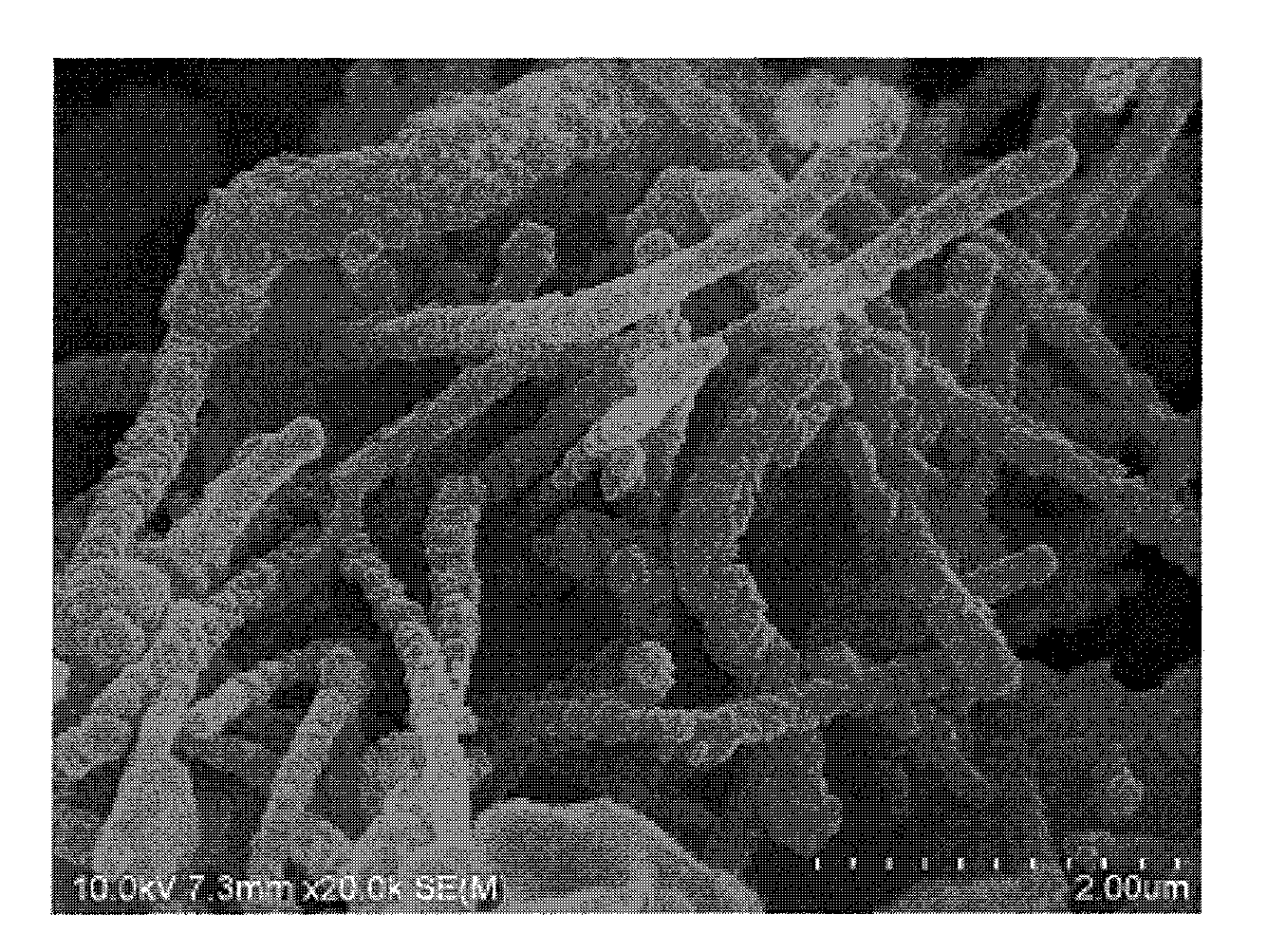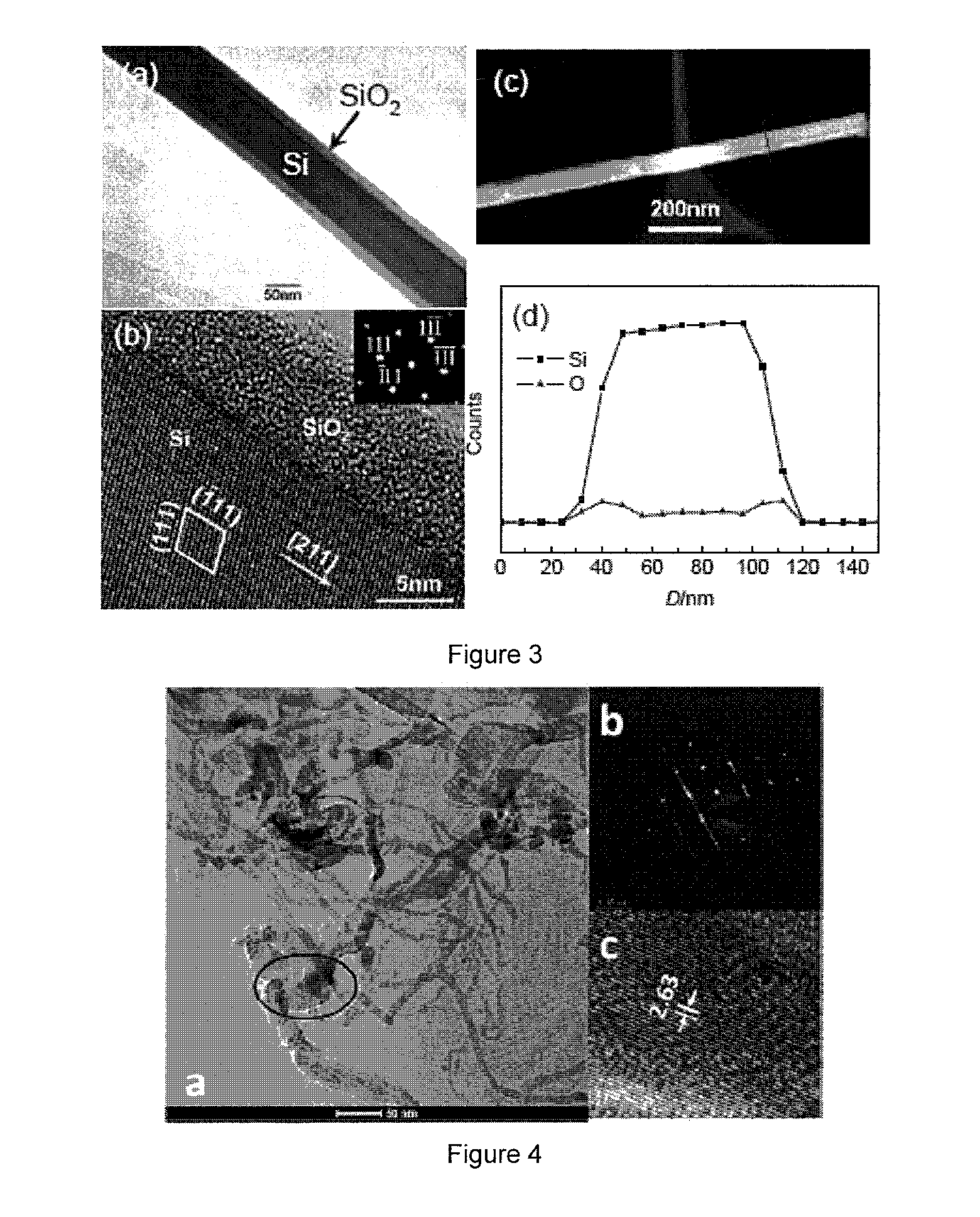NANO silicon-carbon composite material and preparation method thereof
a technology of silicon carbon and composite materials, applied in the direction of carbides, secondary cells servicing/maintenance, cell components, etc., can solve the problems of loss of electric contact, difficult to obtain breakthrough, fast capacity fading, etc., and achieve good cycle stability, short production process, and poor material cycle stability
- Summary
- Abstract
- Description
- Claims
- Application Information
AI Technical Summary
Benefits of technology
Problems solved by technology
Method used
Image
Examples
embodiment 1
[0060]50 wt % of nano SiO2 powder of which the purity is 99.95% is added to deionized water of which the mass percent of the silica is 300% to prepare the silica sol in a planetary agitation tank, wherein the agitation time is 10 hours; and then 50 wt % (totaling 100% of total weight of the SiO2 powder and the graphite flake) of graphite flake of which the particle size is 3-6 μm is added to the silica sol, and evenly mixed by adopting a kneading machine; the evenly agitated slurry is dried in a forced air drying mode, the dried material is subjected to heat preservation for 2 hours under the conditions of 20 MPa of mechanical pressure, 1300° C., and argon, to press into a porous disc of which the diameter is about 80 mm and the thickness is 10 mm, the porosity is 21 vol %, the density is 1.70 g / cm3, and the resistivity is 0.08 Ω·cm. The disc and the conductive cathode collector are compounded and taken as the cathode, a graphite rod is taken as an anode, and CaCl2 is taken as elect...
embodiment 2
[0062]65 wt % of nano SiO2 powder of which the purity is 99.95% is added to ethylene glycol of which the mass percent of the silica is 100% to prepare the silica sol in the planetary agitation tank, wherein the agitation time is one hour; and then 35 wt % (totaling 100% of total weight of the SiO2 powder and the carbon fiber) of commercially available carbon fiber of which the diameter is 20-150 nm and the length is 2-10 μm is added to the silica sol, evenly mixed by adopting the kneading machine; and the mixture of carbon fiber and SiO2 is pressed into a disc of which the diameter is about 10 mm and the thickness is 1.5 mm under the mechanical pressure of 15 MPa; the disc is then sintered in manners of heating at 150° C. in argon for 1.5 hours, and then heated to 1100° C. and keeping the temperature for 3 hours to obtain a porous disc of which the porosity is 55 vol %, the density is 1.00 g / cm3, the resistivity is 98 Ω·cm. The disc and the conductive cathode collector are compounde...
embodiment 3
[0064]65 wt % of nano SiO2 powder of which the purity is 99.95% is added to ethylene glycol of which the mass percent of the silica is 100% to prepare the silica sol in the planetary agitation tank, wherein the agitation time is one hour, and then 35 wt % (totaling 100% of total weight of the SiO2 powder and the carbon fiber) of commercially available carbon fiber of which the diameter is 20-150 nm and the length is 2-10 μm is added to the silica sol, and evenly mixed by adopting the kneading machine; the mixed slurry is dried for 6 hours in an air atmosphere; the dried material is prepared into the porous block in a hot-pressing manner at 1000° C. after being mechanically crushed. The porosity of the porous block is 22 vol %; the density is 1.70 g / cm3; the resistivity is 0.5 Ω·cm. The porous block is machined into a rectangular block of which the length is 50 mm, the width is 30 mm and the height is 10 mm. The rectangular block and the conductive cathode collector are compounded an...
PUM
 Login to View More
Login to View More Abstract
Description
Claims
Application Information
 Login to View More
Login to View More - R&D
- Intellectual Property
- Life Sciences
- Materials
- Tech Scout
- Unparalleled Data Quality
- Higher Quality Content
- 60% Fewer Hallucinations
Browse by: Latest US Patents, China's latest patents, Technical Efficacy Thesaurus, Application Domain, Technology Topic, Popular Technical Reports.
© 2025 PatSnap. All rights reserved.Legal|Privacy policy|Modern Slavery Act Transparency Statement|Sitemap|About US| Contact US: help@patsnap.com



